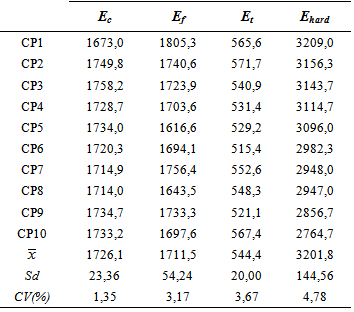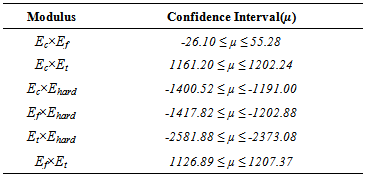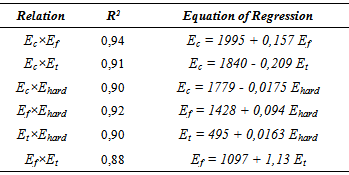-
Paper Information
- Previous Paper
- Paper Submission
-
Journal Information
- About This Journal
- Editorial Board
- Current Issue
- Archive
- Author Guidelines
- Contact Us
International Journal of Materials Engineering
p-ISSN: 2166-5389 e-ISSN: 2166-5400
2014; 4(2): 56-60
doi:10.5923/j.ijme.20140402.02
Evaluation of Mechanical Properties of a Polymer Matrix Thermosetting (Epoxi)
Arthur B. L. Melo1, Túlio Hallak Panzera1, Márcio Eduardo Silveira1, Luciano Donizeti Varanda2, Decio Gonçalves3, André Luis Christoforo4, Francisco Antonio Rocco Lahr3
1Department of Mechanical Engineering, Federal University of São João del-Rei, São João del-Rei, 36307-352, Brazil
2Department of Science and Engineering Material, Engineering School of São Carlos (EESC/USP), São Carlos, 13566-590, Brazil
3Department of Structural Engineering, Engineering School of São Carlos (EESC/USP), São Carlos, 13566-590, Brazil
4Department of Civil Engineering, Federal University of São Carlos, São Carlos, 13565-905, Brazil
Correspondence to: André Luis Christoforo, Department of Civil Engineering, Federal University of São Carlos, São Carlos, 13565-905, Brazil.
| Email: |  |
Copyright © 2012 Scientific & Academic Publishing. All Rights Reserved.
This research objective evaluate the main mechanical properties of epoxy resin, used in composite matrices. The tests carried out (according to standards of ASTM - American Society for Testing and Materials) tensile, compression, bending, Charpy and ultra-micro hardness for determining the following properties: modulus of elasticity, tensile strength, compression and bending, toughness (strain energy) and hardness. Preliminary results showed that the modulus of elasticity in compression is significantly greater than in tension, reaching a difference of more than 100%.The values of module in bending were slightly lower than in compression. This difference of stiffness between tensile and compression of the matrix phase cannot be ignored during the development of the composite. Knowledge of this behavior and allow a better orientation distribution of fibers (or particles) during the development of the composite in order to achieve optimal performance of the final product.
Keywords: Epoxy matrix, Mechanical behavior, Experimental analysis
Cite this paper: Arthur B. L. Melo, Túlio Hallak Panzera, Márcio Eduardo Silveira, Luciano Donizeti Varanda, Decio Gonçalves, André Luis Christoforo, Francisco Antonio Rocco Lahr, Evaluation of Mechanical Properties of a Polymer Matrix Thermosetting (Epoxi), International Journal of Materials Engineering , Vol. 4 No. 2, 2014, pp. 56-60. doi: 10.5923/j.ijme.20140402.02.
1. Introduction
- After the 60s, when the composite had its first ascent, began continuous search for new, leading to continuous development of materials lighter and stronger as the number of features, functionalities and geometries [1].In the foreground, the business aviation industries ought this development because the composites assume greater importance in the project scope. Subsequently, the composite materials are now used also in the automotive industries, the possibility of replacement of parts made of steel, leading to the development of new materials and new and valuable scientific research [2].Among the commonly used matrices stages in the preparation of particulate composites and laminates, we highlight the epoxy resin [1, 12]. The use of epoxy resin characterized the search for discovery of new alliances between materials not previously envisioned [6-8], enabling the use of reinforcing phases in the form of slides and particles derived from organic and inorganic materials [9-11].However, epoxy resins exhibit negative traits as undesirable when an interface not worked properly, and the impossibility of recycling because they belong to the group of thermosetting. Nevertheless, this has been used on a large scale for structural applications [2].Thus, knowledge of elastic properties of epoxy resin through different forms of solicitation as well as the possible correlation between the two shows is very important [3].This work aims to evaluate and correlate the elastic modulus from the uniaxial tensile tests, uniaxial compression, bending and ultra-micro hardness bodies in the test piece made of epoxy resin, allowing a greater understanding of their mechanical behavior.
2. Material and Methods
- The most widely used polymeric resins and cheaper are polyesters and vinyl esters [11]. Epoxies are more expensive and, in addition to commercial applications, are also widely used for aerospace applications; having improved mechanical properties and better resistance to moisture than polyester and vinyl resins.The epoxy resin used was RENLAM M BR 50 KGB1, AL10019400 batch number, together with HY956 hardener REN 25KG BR, B1 AL10014300 batch number, both manufactured by Huntsman Chemical Industry Brazil Ltda.Manufacture of Positive Role Models and negative MoldsThe models were machined in CNC ® (Figure 1), possessing he bodies of the test piece dimensions and shapes required in the regulatory documents used here [13-16], being fabricated and tested 10 samples of the test piece for each of the four tests carried out in mass fractions of 20% hardener and 80% resin.
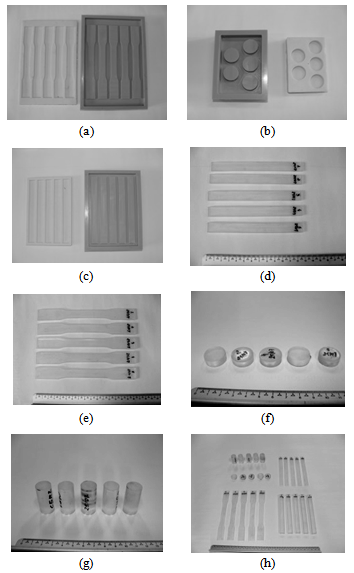 | Figure 1. Models in polymer and silicone molds |
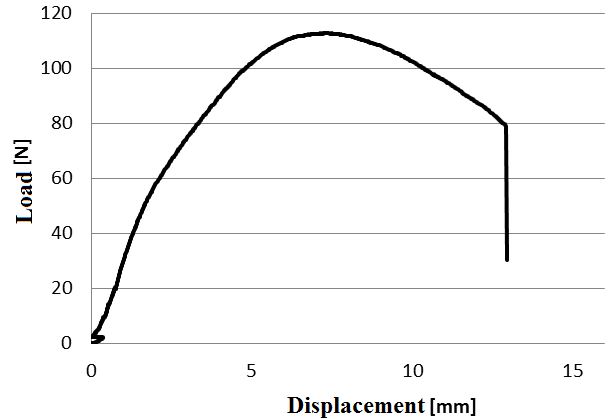 | Figure 2. Force × displacement curve obtained by bending test |
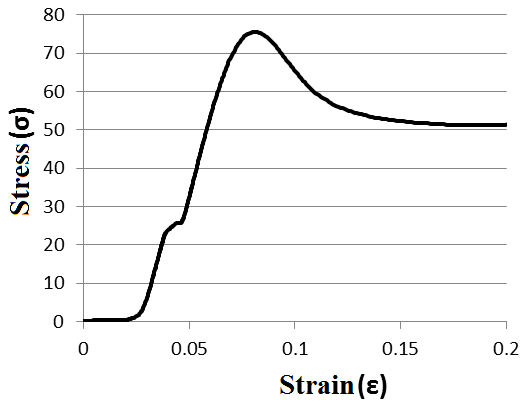 | Figure 3. Stress x strain curve obtained by compressive test |
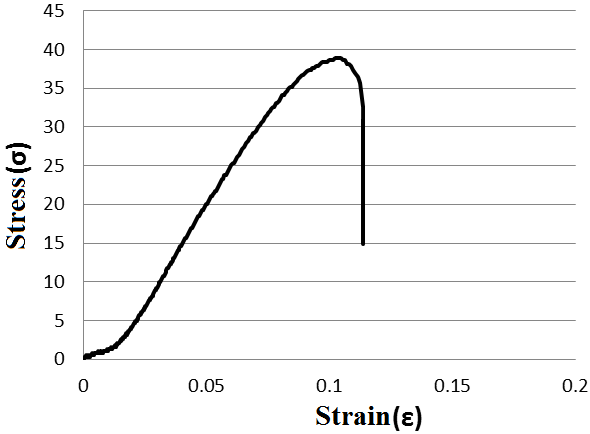 | Figure 4. Tension × deformation curve obtained by tensile test |
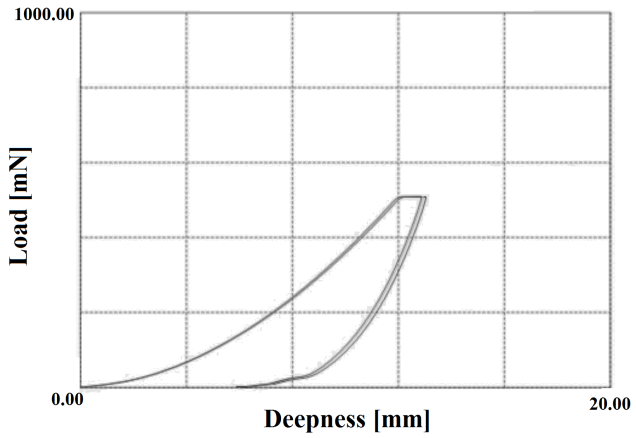 | Figure 5. Load × deepness of hardness test |
 | (1) |
3. Results and Discussions
- Table 1 shows the mean value (
 ), standard deviation (Sd) and coefficient of variation (CV) from the values of elastic modulus obtained for 10 samples of the test piece according to compressive trials (Ec), bending (Ef), tensile (Et) and ultra-micro hardness (Ehard).
), standard deviation (Sd) and coefficient of variation (CV) from the values of elastic modulus obtained for 10 samples of the test piece according to compressive trials (Ec), bending (Ef), tensile (Et) and ultra-micro hardness (Ehard).
|
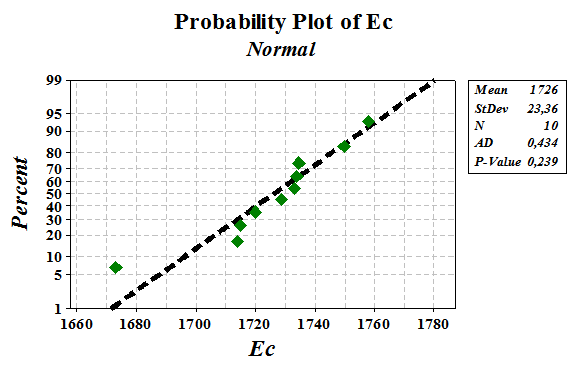 | Figure 6. Normal probability plot for the Ec |
|
|
4. Conclusions
- The epoxy resin behaved as expected, with different modulus of elasticity due to the different forms of application.The modulus of elasticity from the four types of test was normally distributed according to the test of normality Anderson-Darling, allowing the use of the confidence interval.The results of statistical analysis showed equivalence only between the moduli of elasticity obtained from compression and bending tests, being different for other relationships. The correlation coefficients obtained from fits of linear regressions between the modulus of elasticity are in average close to 0.90, indicating a good correlation between variables, allowing the knowledge of a particular test, the prediction of elastic modulus to another form of mechanical stress. The improvement of the correlation between the modules can be established in future studies including a larger number of bodies of the test piece, driving the values for determining the coefficient closer to unity.It should be noted that the results presented relate to the resin measured here and may be different for different. However, it is possible to prove the possibility of the correlation between the four modules from the mechanical tests.
 Abstract
Abstract Reference
Reference Full-Text PDF
Full-Text PDF Full-text HTML
Full-text HTML